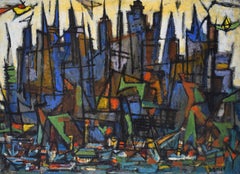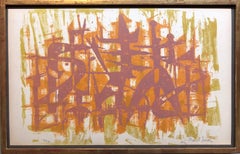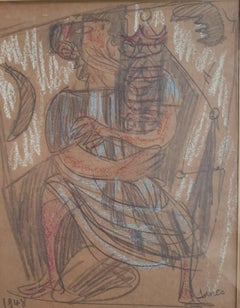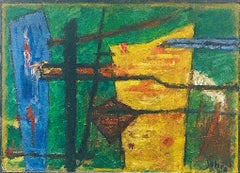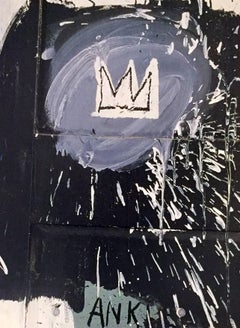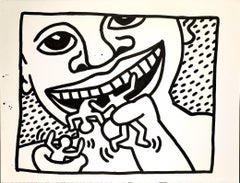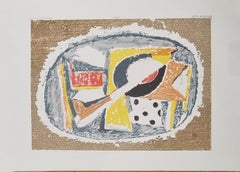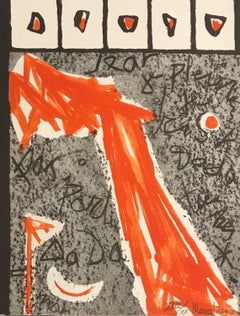Marcel Janco Art
Israeli, Romanian, 1895-1984
Marcel Janco was a Romanian and Israeli visual artist, architect and art theorist. He was the co-inventor of Dadaism and a leading exponent of Constructivism in Eastern Europe.
Janco expounded a "revolutionary" vision of urban planning. He designed some of the most innovative landmarks of downtown Bucharest. He worked in many art forms, including illustration, sculpture and oil painting.
Janco was one of the leading Romanian Jewish intellectuals of his generation. Targeted by antisemitic persecution before and during World War II, he emigrated to the British Mandate for Palestine in 1941. He won the Dizengoff Prize and Israel Prize, and was a founder of Ein Hod, a utopian art colony.(Biography provided by Kings Gallery)
to
1
3
3
3
4
2
2
1
3
Overall Height
to
Overall Width
to
3
1
3
2
1
1
1
1
1
7
1
3
8
6,910
3,240
2,514
1,217
5
3
2
2
2
Artist: Marcel Janco
Harbour View - Cityscape Abstract Dada Romanian Israeli
By Marcel Janco
Located in London, GB
This work is signed by the artist “Janco”, in the lower right corner.
Condition: Good condition. Minor areas of craquelure, particularly along the edges of the canvas. Mild surface ...
Category
1930s Abstract Marcel Janco Art
Materials
Oil, Canvas
DADA Artist Abstract Figures Silkscreen Lithograph Print Israeli Modernist
By Marcel Janco
Located in Surfside, FL
Marcel Janco, was a Romanian and Israeli visual artist, architect and art theorist. He was the co-inventor of Dadaism and a leading exponent of Constructivism in Eastern Europe. In...
Category
20th Century Modern Marcel Janco Art
Materials
Screen, Lithograph
Dancing Hassid
By Marcel Janco
Located in Tel Aviv - Jaffa, IL
Original mixed media on paper
Combining pastel, watercolor and pencil
Hand signed and dated lower right
Unique piece
Category
1940s Dada Marcel Janco Art
Materials
Oil Pastel, Watercolor, Pencil
No title
By Marcel Janco
Located in Tel Aviv - Jaffa, IL
Original ink on paper
Hand signed lower right
Unique piece
Category
1940s Dada Marcel Janco Art
Materials
Ink
Untitled
By Marcel Janco
Located in Lawrence, NY
We are pleased to present this vivid, modernist work by Marcel Janco, one of the founders of Dada. It is housed in a stunning House of Heydenryk frame.
Marcel Janco was a Romanian-Israeli-Jewish painter who was one of the founders of Dadaism and a noted modernist architect. His career evinced the modern artist's interest in the primitive in art.
In its earliest years, the Romanian avant-garde flourished mainly outside of Romania, thanks to the conservative and nationalistic mood of that country during the post-World War I era. Dada, the anti-art movement, was hatched by a group of Romanian expatriate artists, Tristan Tzara (born Sami Rosenstein), Marcel Janco and other intellectuals working in Zurich in 1915.
The Dada movement, which later took root in other centers in Europe and the United States, fostered an abandonment of traditional artistic methods and forms and urged an approach to art without preconceived ideas. A manifesto by Tristan Tzara said that Dada meant nothing, that ''we want works, straightforward, strong, accurate and forever not understood, logic is always wrong.''
Janco built the scenery for Cabaret Voltaire in Zurich that was the first Dadaist meeting place, and he was one of the most energetic members of the Zurich group. At the cabaret the members of the group put on shows and performances that were alien to and completely different from anything to which the bourgeois society of Zurich was accustomed. Marcel Janco was a full partner in all the group's activities - he created the masks they wore during stage performances, and took part in the shows that evoked great rage and indignant responses from the audience. A Dada construction of his was reproduced on the cover of Dada, the group's magazine, published in 1917. His best known Dadaist works were abstract, architectonic plaster reliefs, one of which is in the collection of the MOMA.
Janco had his first exhibition at Cafe Voltaire in 1916. In 1917, Janco exhibited at the first Dada show in Zurich at the Dada gallery together with Hans Arp, Giorgio de Chirico, Paul Klee, and Tzara. In 1918, he became a member of Das Neue Leben, a group of artists in Basel that included Arp, Fritz Baumann, Augusto Giacometti...
Category
1940s Abstract Expressionist Marcel Janco Art
Materials
Oil
"La Mer Noire" Figurative Dada Artist Proof
By Marcel Janco
Located in Houston, TX
Post-impressionist style artist proof lithograph of figures. The work is similarly to the style of Paul Gauguin's Tahiti paintings. The work is signed and titled by the artist. It is framed in a gold frame with a white matte.
Dimensions without Frame: H 18.5in x W 24in.
Artist Biography: Marcel Janco was a Romanian and Israeli visual artist, architect and art theorist. He was the co-inventor of Dadaism and a leading exponent of Constructivism in Eastern Europe. In the 1910s, he co-edited, with Ion Vinea and Tristan Tzara, the Romanian art magazine Simbolul. Janco was a practitioner of Art Nouveau, Futurism and Expressionism before contributing his painting and stage design to Tzara's literary Dadaism. He parted with Dada in 1919, when he and painter Hans Arp founded a Constructivist circle, Das Neue Leben.
Reunited with Vinea, he founded Contimporanul, the influential tribune of the Romanian avant-garde, advocating a mix of Constructivism, Futurism and Cubism. At Contimporanul, Janco expounded a "revolutionary" vision of urban planning. He designed some of the most innovative landmarks of downtown Bucharest. He worked in many art forms, including illustration, sculpture and oil painting.
Janco was one of the leading Romanian Jewish...
Category
20th Century Dada Marcel Janco Art
Materials
Lithograph
Yellow Square, Red Square and Blue Triangle
By Marcel Janco
Located in London, GB
MARCEL JANCO 1895-1984
Bucarest 1895-1984 Ein Hod (Rumanian/Israeli)
Title: Yellow Square, Red Square and Blue Triangle
Technique: Original signed Oil ...
Category
20th Century Abstract Marcel Janco Art
Materials
Canvas, Oil
Reclining Nude
By Marcel Janco
Located in London, GB
MARCEL JANCO 1895-1984
Bucarest 1895-1984 Ein Hod (Rumanian/Israeli)
Title: Reclining Nude
Technique: Original signed Watercolour and Ink on paper
s...
Category
Dada Marcel Janco Art
Materials
Ink, Paper, Watercolor
Related Items
Basquiat Paris 1998 (vintage Basquiat announcement)
By after Jean-Michel Basquiat
Located in NEW YORK, NY
Basquiat Paris 1998:
Rare vintage original announcement card to the exhibit, Jean-Michel Basquiat Temoignage 1977-1988, Galerie Jerome De Noirmont, Paris, 1998:
6 x 9 inches (folde...
Category
1980s Pop Art Marcel Janco Art
Materials
Offset, Lithograph
Untitled, 1982 (Cannibal)
By Keith Haring
Located in Greenwich, CT
Untitled, 1982 is a sumi ink on paper, 38.25 x 50" image size, signed and dated verso 'SEPT.21 - 82 + K. Haring' and framed in a custom, gold-leaf frame.
Haring’s image of a man-eating monster is partly influenced by the artist Hieronymus Bosch as Haring often cited Bosch’s The Garden of Earthly...
Category
1980s Pop Art Marcel Janco Art
Materials
Paper, Sumi Ink
La Conférence à la Sorbonne, 3 Juin, 1959, Lt Ed Silkscreen cover record albums
By Yves Klein
Located in New York, NY
Yves Klein
La Conférence à la Sorbonne, 3 Juin, 1959, 1959-1963
Two 12-inch vinyl records held in gatefold sleeve with silkscreen cover jacket in IKB International Klein Blue...
Category
1960s Modern Marcel Janco Art
Materials
Plastic, Mixed Media, Screen, Offset, Pencil, Board, Lithograph
H 12.7 in W 12.7 in D 2 in
"Love, Monterey" Colorful Abstract Expressionist Triptych by Kristy Chettle
By Kristy Chettle
Located in Carmel, CA
In this 12" x 36" abstract expressionist triptych, artist Kristy Chettle captures the vibrant essence of Monterey Bay's varied landscapes. The panels are a symphony of color, with ce...
Category
2010s Abstract Expressionist Marcel Janco Art
Materials
Oil, Panel
H 12 in W 38 in D 1.5 in
Pastel-Toned Abstract Impressionist Venice Grand Canal Landscape
By Jane Peterson
Located in Houston, TX
Pastel pink, blue, and purple toned Venice Canal abstract impressionist landscape by American artist Jane Peterson. This painting depicts what seems to be an early morning scene feat...
Category
Mid-20th Century Abstract Impressionist Marcel Janco Art
Materials
Canvas, Oil
H 25 in W 31 in D 2.25 in
The Abduction of the Sabine Women , a Renaissance drawing by Biagio Pupini
Located in PARIS, FR
This vigorous drawing has long been attributed to Polidoro da Caravaggio: The Abduction of the Sabine Women is one of the scenes that Polidoro depicted between 1525 and 1527 on the façade of the Milesi Palazzo in Rome. However, the proximity to another drawing inspired by this same façade, kept at the Ecole des Beaux-Arts, and to other drawings inspired by Polidoro kept at the Musée du Louvre, leads us to propose an attribution to Biagio Pupini, a Bolognese artist whose life remains barely known, despite the abundant number of drawings attributed to him.
1. Biagio Pupini, a Bolognese artist in the light of the Roman Renaissance
The early life of Biagio Pupini, an important figure of the first half of the Cinquecento in Bologna - Vasari mentions him several times - is still poorly known. Neither his date of birth (probably around 1490-1495) nor his training are known. He is said to have been a pupil of Francesco Francia (1450 - 1517) and his name appears for the first time in 1511 in a contract with the painter Bagnacavallo (c. 1484 - 1542) for the frescoes of a church in Faenza. He then collaborated with Girolamo da Carpi, at San Michele in Bosco and at the villa of Belriguardo.
He must have gone to Rome for the first time with Bagnacavallo between 1511 and 1519. There he discovered the art of Raphael, with whom he might have worked, and that of Polidoro da Caravaggio. This first visit, and those that followed, were the occasion for an intense study of ancient and modern art, as illustrated by his abundant graphic production.
Polidoro da Caravaggio had a particular influence on the technique adopted by Pupini. Executed on coloured paper, his drawings generally combine pen, brown ink and wash with abundant highlights of white gouache, as in the drawing presented here.
2. The Abduction of the Sabine Women
Our drawing is an adaptation of a fresco painted between 1525 and 1527 by Polidoro da Caravaggio on the façade of the Milesi Palace in Rome. These painted façades were very famous from the moment they were painted and inspired many artists during their stay in Rome. These frescoes are now very deteriorated and difficult to see, as the palace is in a rather narrow street.
The episode of the abduction of the Sabine women (which appears in the centre of the photo above) is a historical theme that goes back to the origins of Rome and is recounted both by Titus Livius (Ab Urbe condita I,13), by Ovid (Fasti III, 199-228) and by Plutarch (II, Romulus 14-19). After killing his twin brother Romus, Romulus populates the city of Rome by opening it up to refugees and brigands and finds himself with an excess of men. Because of their reputation, none of the inhabitants of the neighbouring cities want to give them their daughters in marriage. The Romans then decide to invite their Sabine neighbours to a great feast during which they slaughter the Sabines and kidnap their daughters.
The engraving made by Giovanni Battista Gallestruzzi (1618 - 1677) around 1656-1658 gives us a good understanding of the Polidoro fresco, allowing us to see how Biagio Pupini reworked the scene to extract this dynamic group.
With a remarkable economy of means, Biagio Pupini takes over the left-hand side of the fresco and depicts in a very dense space two main groups, each consisting of a Roman and a Sabine, completed by a group of three soldiers in the background (which seems to differ quite significantly from Polidoro's composition).
The balance of the drawing is based on a very strongly structured composition. The drawing is organised around a median vertical axis, which runs along both the elbow of the kidnapped Sabine on the left and the foot of her captor, and the two main diagonals, reinforced by four secondary diagonals. This diamond-shaped structure creates an extremely dynamic space, in which centripetal movements (the legs of the Sabine on the right, the arm of the soldier on the back at the top right) and centrifugal movements (the arm of the kidnapper on the left and the legs of the Sabine he is carrying away, the arm of the Sabine on the right) oppose each other, giving the drawing the appearance of a whirlpool around a central point of support situated slightly to the left of the navel of the kidnapper on the right.
3. Polidoro da Caravaggio, and the decorations of Roman palaces
Polidoro da Caravaggio was a paradoxical artist who entered Raphael's (1483 - 1520) workshop at a very young age, when he oversaw the Lodges in the Vatican. Most of his Roman work, which was the peak of his career, has disappeared, as he specialised in facade painting, and yet these paintings, which are eminently visible in urban spaces, have influenced generations of artists who copied them abundantly during their visits to Rome.
Polidoro Caldara was born in Caravaggio around 1495-1500 (the birthplace of Michelangelo Merisi, known as Caravaggio, who was born there in 1571), some forty kilometres east of Milan. According to Vasari, he arrived as a mason on the Vatican's construction site and joined Raphael's workshop around 1517 (at the age of eighteen according to Vasari). This integration would have allowed Polidoro to work not only on the frescoes of the Lodges, but also on some of the frescoes of the Chambers, as well as on the flat of Cardinal Bibiena in the Vatican.
After Raphael's death in 1520, Polidoro worked first with Perin del Vaga before joining forces with Maturino of Florence (1490 - 1528), whom he had also known in Raphael's workshop. Together they specialised in the painting of palace façades. They were to produce some forty façades decorated with grisaille paintings imitating antique bas-reliefs.
The Sack of Rome in 1527, during which his friend Maturino was killed, led Polidoro to flee first to Naples (where he had already stayed in 1523), then to Messina. It was while he was preparing his return to the peninsula that he was murdered by one of his assistants, Tonno Calabrese, in 1543.
In his Vite, Vasari celebrated Polidoro as the greatest façade decorator of his time, noting that "there is no flat, palace, garden or villa in Rome that does not contain a work by Polidoro". Polidoro's facade decorations, most of which have disappeared as they were displayed in the open air, constitute the most important lost chapter of Roman art of the Cinquecento. The few surviving drawings of the painter can, however, give an idea of the original appearance of his murals and show that he was an artist of remarkable and highly original genius.
4. The façade of the Milesi Palace
Giovanni Antonio Milesi, who commissioned this palace, located not far from the Tiber, north of Piazza Navona, was a native of the Bergamo area, like Polidoro, with whom he maintained close friendly ties. Executed in the last years before the Sack of Rome, around 1526-1527, the decoration of Palazzo Milesi is considered Polidoro's greatest decorative success.
An engraving by Ernesto Maccari made at the end of the nineteenth century allows us to understand the general balance of this façade, which was still well preserved at the time. The frescoes were not entirely monochrome, but alternated elements in chiaroscuro simulating marble bas-reliefs and those in ochre simulating bronze and gold vases...
Category
16th Century Old Masters Marcel Janco Art
Materials
Ink, Gouache, Pen
Untitled (View of Provincetown Harbor)
By Hans Hofmann
Located in Palm Desert, CA
"Untitled (View of Provincetown Harbor)", is an oil on panel work made by Hans Hofmann circa 1937. The work is stamped verso by the estate of Hans Hofmann. The artwork size is 17 1/4...
Category
Early 20th Century Abstract Expressionist Marcel Janco Art
Materials
Oil, Panel
Josef Albers Homage to the Square 1977 (Josef Albers prints)
By (after) Josef Albers
Located in NEW YORK, NY
Josef Albers Homage to the Square 1977:
Screen-print in colors on heavy double-folded wove paper from the Verlag Aurel Bongers 1977 monograph approved by Albers shortly before his d...
Category
1960s Pop Art Marcel Janco Art
Materials
Screen, Lithograph
I Want Pizza by Daniel Johnston Ink on paper
Located in Austin, US
I Want Pizza by Daniel Johnston
original ink on paper
measures 8.5" x 11"
Est. late 1970s
Signed au recto in ink by the artist
In excellent condition for its age with no rips on the paper
This drawing was part of Power Pathos, a 2006 Station Museum of Contemporary Art (Houston, TX) exhibit showcasing the work of five artists: Ron English, Clark Fox...
Category
Late 20th Century Outsider Art Marcel Janco Art
Materials
Ink
Abstract Expressionist, Art Brut Lithograph, 'A Day Out'.
Located in Cotignac, FR
Abstract Expressionist lithograph on BFK Rives paper of a late 20th century work by French artist Eliane Larus.
A lively and highly colourful lithograph...
Category
Late 20th Century Abstract Expressionist Marcel Janco Art
Materials
Lithograph
Saul Steinberg lithograph 1970s (Saul Steinberg prints)
By Saul Steinberg
Located in NEW YORK, NY
Vintage Saul Steinberg Lithograph
Published by: Galerie Maeght, Paris, c.1970
Portfolio: Derrière le miroir
Excellent frame piece
Lithograph in colors
15 x 22 inches
Fold-line as i...
Category
1970s Pop Art Marcel Janco Art
Materials
Lithograph
Some People Together
By Karel Appel
Located in New York, NY
Some People Together, 1974
Hand-signed and dated in pencil
Color lithograph and screenprint
Sheet 22 x 29 3/4 inches; 559 x 756 mm.
Edition 110
Category
1970s Modern Marcel Janco Art
Materials
Lithograph, Screen
Previously Available Items
DADA
By Marcel Janco
Located in Jerusalem, IL
Hand signed DADA abstract lithograph by famous Romanian- Israeli artist Marcel Janco. Part of a serie of 100 prints. hand signed 61/100.
Category
Mid-20th Century Marcel Janco Art
Materials
Lithograph
Hommage à Hans Arp
By Marcel Janco
Located in Paris, FR
Lithograph
Handsigned by the artist in pencil and numbered XVIII/XX
Publisher : Galerie Im Erker St. Gallen
LCD4677
Category
1970s Abstract Marcel Janco Art
Materials
Lithograph
Rare Dada Artist Israeli Watercolor Painting Abstract Landscape Marcel Janco
By Marcel Janco
Located in Surfside, FL
site size 13 X 16 inches. framed to 22.5 X 25 inches. A relatively large size for his works on paper.
Marcel Janco, was a Romanian and Israeli visual artist, architect and art theorist. He was the co-inventor of Dadaism and a leading exponent of Constructivism in Eastern Europe. In the 1910s, he co-edited, with Ion Vinea and Tristan Tzara, the Romanian art magazine Simbolul. Janco was a practitioner of Art Nouveau, Futurism and Expressionism before contributing his painting and stage design to Tzara's literary Dadaism. He parted with Dada in 1919, when he and painter Hans Jean Arp founded a Constructivist circle, Das Neue Leben.
Reunited with Vinea, he founded Contimporanul, the influential tribune of the Romanian avant-garde, advocating a mix of Constructivism, Futurism and Cubism. At Contemporanul, Janco expounded a "revolutionary" vision of urban planning. He designed some of the most innovative landmarks of downtown Bucharest. He worked in many art forms, including illustration, sculpture and oil painting.
Janco was one of the leading Romanian Jewish intellectuals of his generation. Targeted by antisemitic persecution and during World War II, he emigrated to British Palestine in 1941. He won the Dizengoff Prize and Israel Prize, and was a founder of Ein Hod, a utopian art...
Category
Mid-20th Century Modern Marcel Janco Art
Materials
Paper, Ink, Watercolor
Composition Duele
By Marcel Janco
Located in London, GB
MARCEL JANCO 1895-1984
Bucarest 1895-1984 Ein Hod (Rumanian/Israeli)
Title: Composition Duele
Technique: Original Signed Oil painting on canvas laid on car...
Category
1980s Cubist Marcel Janco Art
Materials
Oil
Emblems, Rare Large Dada Hand Woven Israeli Aubusson Wool Tapestry Wall Hanging
By Marcel Janco
Located in Surfside, FL
This is an Aubusson style flat weave hand woven wool tapestry. it is edition 6/8. Hand signed. Executed at Itche mambush studios Ein Hod Artists Village. He worked with Mordecai Ardon, Robert Helman...
Category
Mid-20th Century Modern Marcel Janco Art
Materials
Wool
DADA Artist Abstract Figures Silkscreen Lithograph Print Israeli Modernist
By Marcel Janco
Located in Surfside, FL
Marcel Janco, was a Romanian and Israeli visual artist, architect and art theorist. He was the co-inventor of Dadaism and a leading exponent of Constructivism in Eastern Europe. In the 1910s, he co-edited, with Ion Vinea and Tristan Tzara, the Romanian art magazine Simbolul. Janco was a practitioner of Art Nouveau, Futurism and Expressionism before contributing his painting and stage design to Tzara's literary Dadaism. He parted with Dada in 1919, when he and painter Hans Arp founded a Constructivist circle, Das Neue Leben.
Reunited with Vinea, he founded Contimporanul, the influential tribune of the Romanian avant-garde, advocating a mix of Constructivism, Futurism and Cubism. At Contimporanul, Janco expounded a "revolutionary" vision of urban planning. He designed some of the most innovative architectural landmarks of downtown Bucharest. He worked in many art forms, including architecture, illustration, sculpture and oil painting.
Janco was one of the leading Romanian Jewish intellectuals of his generation. Targeted by antisemitic persecution before and during World War II, he emigrated to British Palestine in 1941. He won the Dizengoff Prize and Israel Prize, and was a founder of Ein Hod, a utopian art colony, populated by many famous israeli artists including Zahara Schatz Boris Schatz daughter, Aryeh Navon and michael gross. He has been in many exhibits including Ofakim Hadashim the "New Horizons" in 1948, the Tel Aviv Museum of Art opened the first exhibit bearing the movement's name. Among the artists showing were Pinchas Abramovich, Marcel Janco, Aharon Kahana, Yohanan Simon, Avshalom Okashi...
Category
20th Century Modern Marcel Janco Art
Materials
Lithograph, Screen
DADA Artist Watercolor Painting and Drawing Israeli Modernist
By Marcel Janco
Located in Surfside, FL
This depicts an indigenous Yemenite, Sephardic or Arab man in traditional Middle eastern dress. possibly from the makeshift transit camps (the ma'...
Category
20th Century Modern Marcel Janco Art
Materials
Paper, Watercolor, Color Pencil
Cube
By Marcel Janco
Located in New York, NY
Plaster print on burlap canvas.
The inspiration for this work is works he did in the 20's.
This work is part of an edition that was not numbered by Janco
Category
1960s Abstract Marcel Janco Art
Materials
Canvas, Plaster
Composition
By Marcel Janco
Located in New York, NY
Marcel Janco was a Romanian and Israeli visual artist, architect and art theorist. He was the co-inventor of Dadaism and a leading exponent of Constructivism in Eastern Europe. In the 1910s, he co-edited, with Ion Vinea and Tristan Tzara, the Romanian art magazine Simbolul. Janco was a practitioner of Art Nouveau, Futurism and Expressionism before contributing his painting and stage design to Tzara's literary Dadaism. He parted with Dada in 1919, when he and painter Hans Arp founded a Constructivist circle, Das Neue Leben.
Reunited with Vinea, he founded Contimporanul, the influential tribune of the Romanian avant-garde, advocating a mix of Constructivism, Futurism and Cubism. At Contimporanul, Janco expounded a "revolutionary" vision of urban planning. He designed some of the most innovative landmarks of downtown Bucharest. He worked in many art forms, including illustration, sculpture and oil painting.
Janco was one of the leading Romanian Jewish intellectuals of his generation. Targeted by antisemitic persecution before and during World War II, he emigrated to British Palestine in 1941. He won the Dizengoff Prize and Israel Prize, and was a founder of Ein Hod, a utopian art...
Category
1960s Abstract Geometric Marcel Janco Art
Materials
Metal
Luxembourg Garden Rare Large Dada Handwoven Aubusson (Israeli) Tapestry
By Marcel Janco
Located in Surfside, FL
This is an Aubusson style flat weave hand woven wool tapestry. it is edition 1/8 (I doubt they were all made) Executed at Itche mambush studios Ein Hod Artists Village. He worked with Mordecai Ardon, Robert Helman...
Category
20th Century Modern Marcel Janco Art
Materials
Wool
Marcel Janco art for sale on 1stDibs.
Find a wide variety of authentic Marcel Janco art available for sale on 1stDibs. If you’re browsing the collection of art to introduce a pop of color in a neutral corner of your living room or bedroom, you can find work that includes elements of blue and other colors. You can also browse by medium to find art by Marcel Janco in paint, lithograph, ink and more. Much of the original work by this artist or collective was created during the 20th century and is mostly associated with the abstract style. Not every interior allows for large Marcel Janco art, so small editions measuring 6 inches across are available. Customers who are interested in this artist might also find the work of André Thomkins, and Marcel Duchamp. Marcel Janco art prices can differ depending upon medium, time period and other attributes. On 1stDibs, the price for these items starts at $150 and tops out at $12,000, while the average work can sell for $1,050.
